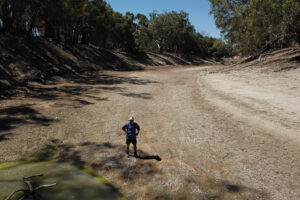Share
by Maryanne Slattery
[Originally published in The Canberra Times, 13 July 2019]
The Murray-Darling Basin is broken. Literally. As in its parts aren’t joined up anymore – the Darling River/Barka hasn’t flowed into the Murray since 2017. The Murrumbidgee isn’t flowing into the Murray either and will be disconnected from the rest of the basin more regularly due to new irrigation development.
I know, I know: sunburnt country, drought and flooding rain, our rivers are variable. This disconnection of the river system has happened before. But there are a lot of firsts this time around, here are just three:
- One million dead fish in the Darling, some decades old, that had survived plenty of droughts before.
- Hundreds of dairy farmers walking off the land in recent months, some fourth and fifth generation farmers, despite many having state-of-the-art operations.
- Small irrigators along the NSW Murray joining a class action to sue the Murray Darling Basin Authority for $750 million over wasted water.
These problems developed while hundreds of millions of dollars have been paid by governments to well-connected corporations, often for water rights that exist largely on paper.
This is not an issue of “agriculture vs the environment”. The issue is the public interest vs entrenched political, bureaucratic and business interests.
This week, Four Corners featured a range of farmers and water policy experts claiming that billions have been wasted in the basin, often for minimal environmental benefit. It showed huge new dams being built by Webster Limited, with taxpayer subsidies. Webster is chaired by businessman Chris Corrigan, of 1990s waterfront fame.
The show didn’t feature any politicians or bureaucrats, who had all refused, or been told to refuse, interviews. It didn’t feature any of the big agribusiness lobbyists either. Perhaps it should have. They certainly have different opinions, which they then spent all week airing.
The National Irrigators Council, the National Farmers Federation and Cotton Australia were all out dismissing experts who, they say, “don’t depend on the basin”. Ironically, Corrigan himself dialled into a radio interview from Europe – well outside the basin – where he divides his time between Switzerland and Italy.
The business representatives’ claims are exactly the same as those of the various water ministers and agencies – that every drop has been accounted for and there’s nothing to see here. Anyone questioning any aspect of basin management can expect a serve from the political-bureaucratic-business interests.
This is preventing open discussion of the problems of the basin and their potential solutions. The problems are large and real, as shown by the Webster example in the Murrumbidgee.
Webster has built huge new private dams on the Hay Plains, near where the Murrumbidgee meets the Murray. Even by Australian standards, this area is impressively flat and hot. Irrigation has never taken place here because of the size of dams needed and the evaporation rates out of such dams.
Under the government’s so-called Water Efficiency Program, Webster received at least $41 million from the Commonwealth to help build these dams and in return gave up water licences, valued at perhaps half that. This multimillion-dollar short changing of the taxpayer is just one part of the problem.
The entire point of the “efficiency program”, where taxpayers pay to upgrade private infrastructure, is to keep irrigators on their land while saving water. The other option, government simply buying back water rights, is opposed by many communities who fear that it buys them out of existence. Barnaby Joyce largely ended this practice when he was minister for agriculture and water resources.
While Webster’s dams are in the Murrumbidgee, much of the water rights surrendered by Webster were actually for the Murray. Webster had no operations in the relevant area of the Murray, they had simply bought water there from dairy, grain or fodder producers. As far as the Murray area is concerned, this is no different to a government buyback, it’s just done by a corporation.
So, taxpayers and communities have been dudded, but did this deal at least save water? On paper perhaps, but there is a lot of creative accounting in the basin.
Webster gave up water in an existing irrigation district, in exchange for developing irrigation on a greenfield site on the Hay Plain. Irrigation has never been viable here before, as water is hard to use-unless taxpayers have built you some huge new dams to store it in, that is. No one has ever explained how a new irrigation area with high evaporation rates could possibly be “saving water”.
With no irrigation in the area until now, previously much of this water flowed naturally into wetlands and on into the Murray. While rights to the water may have been owned by landholders, they couldn’t use it without big storages. It was a reliable and near-natural flow to the environment. Furthermore, flowing into the Murray, it was a resource for irrigators there. Now, however, this water will irrigate cotton and nuts in the Murrumbidgee and less water will go to the environment and Murray irrigators.
With more transparency, consultation and openness to change, the Murray Darling Basin could be much better managed. But the powerful business, political and bureaucratic forces in the basin can’t, or won’t, acknowledge the very existence of a problem. Instead, their usual response is to blame drought or to blame critics of having an agenda and trying to bring down the Basin Plan. This leaves no space to have an honest discussion about the policies and implementation that isn’t simply working.
The reason no dissent can be tolerated is that the basin is connected physically (ideally) and on paper. An adjustment to one aspect of the basin’s management means changes required elsewhere. If water savings projects in one valley are found not to have been effective, it could affect projects in other valleys-not just the farms, but the consultants and bureaucrats who oversaw those projects in the first place. The water recovery targets might need to be changed, creating a world of problems for those trying to implement the Basin Plan.
There is plenty at stake for businesses, politicians and public servants. Eight billion dollars has been spent on the Basin Plan and much of that has not gone to helping the rivers as it was supposed to.
Political careers have been made and lost in the Basin. NSW Nationals lost two previously “unlosable” seats in there in last election, and not long after, Niall Blair was no longer the water minister. Another NSW Minister resigned after a separate Four Corners episode exposed large-scale water theft in the northern basin.
Basin bureaucrats have built careers around implementing the Murray Darling’s water reforms, which are watched closely internationally. MDBA staff were flown to Brazil for last year’s World Water Forum without having to prepare or publish any kind of research. The chair of an MDBA panel consults to the Iranian government on water. Representatives of the Mekong River Commission recently visited to admire the basin’s management. There are no shortage of potential international appointments or consulting opportunities for those who play their cards right in our water agencies.
Fixing something that is broken can be hard. It’s even harder when some of its users pretend there isn’t a problem. Fixing the basin will need more transparency and more accountability. A federal Royal Commission would be a big step in the right direction.
- Maryanne Slattery is senior water researcher at independent think tank The Australia Institute
- Twitter: @MaryanneSlatte1
Between the Lines Newsletter
The biggest stories and the best analysis from the team at the Australia Institute, delivered to your inbox every fortnight.
You might also like
Murray-Darling Polling: Majority Support for water buybacks across Basin States, Party Lines and Regional Australia
New research released today by The Australia Institute shows strong public support for changes to Murray Darling Basin environmental and water rules.
Farmers Unite to Support Water Buybacks as Water Amendment Bill Clears Senate
Farmers and irrigators have joined the Australia Institute in a national campaign to support voluntary buybacks, with the Water Amendment (Restoring Our Rivers) Bill 2023 passing the Senate today, clearing the way for important Murray-Darling basin reforms to become law.
Murray-Darling: Irrigators and farmers support water buybacks in new ad campaign
The Australia Institute and farmers will run full-page ads in leading rural newspapers in all Basin States this week supporting water recovery through voluntary buybacks.

